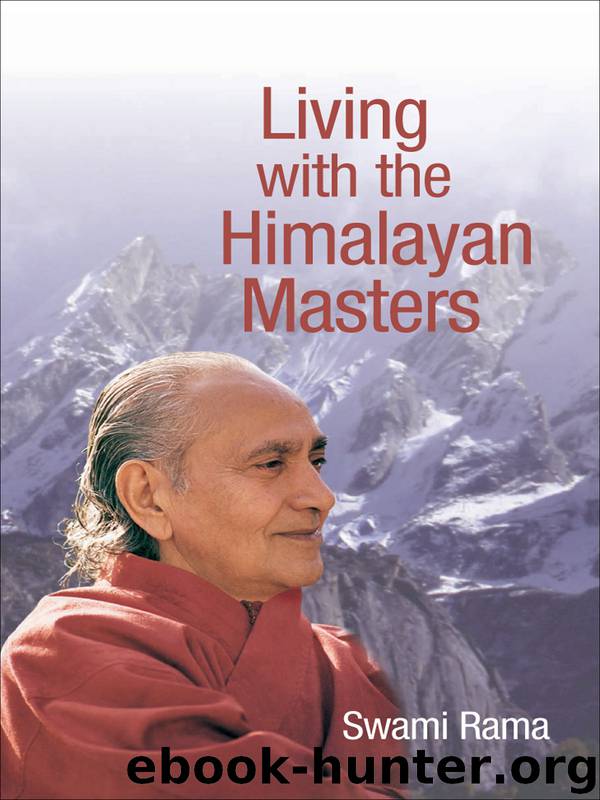Living with the Himalayan Masters by Swami Rama

Author:Swami Rama
Language: eng
Format: epub, mobi
Publisher: Himalayan Institute Press
Published: 2007-03-26T16:00:00+00:00
Maharshi Raman
Dr. T. N. Dutta, a prominent physician from Gajipur, U.P., wrote to me that he was coming to see me at Nasik, where I was living. After visiting, he told me his reason for coming. He said he was very anxious to take me with him to Arunachala in South India to have darshan of Maharshi Raman. In the winter of 1949 we left for Arunachala. My stay at this ashram was brief, but very pleasant. During those days Maharshi Raman was observing silence. There were several foreign students staying in the ashram. Shastriji, one of his prominent disciples, would give discourses and Maharshi Raman would sit quietly.
There was one thing that I found in his presence which was very rare and which I seldom found elsewhere. For those whose hearts were open to that voice of silence which was perennially radiating in the ashram, just sitting near him was enough to answer any question arising from within. It is true that to be in the presence of a great man is the same as experiencing savikalpa samadhi [“samadhi with a form”]. Maharshi Raman did not have a physical guru. “He is the greatest and holiest man born on the soil of India within a hundred years’ period,” said Dr. Radhakrishnan. A glance of such a great man purifies the way of the soul.
According to Maharshi Raman, contemplating on the single query “Who am I?” can lead the aspirant to the state of self-realization. Though this method of contemplation is the foundation stone of the philosophies of both the East and the West, it was revived again by Maharshi Raman. The entire Vedanta philosophy was brought into practice by the Maharshi. “He put the Iliad in a nutshell”: By knowing oneself, one knows the self of all. The very simple, profound method of self-inquiry is accepted by both Easterners and Westerners.
After five days’ stay in the spiritually vibrant atmosphere of Arunachala we came back to Nasik. After visiting this great sage I decided to resign the dignity and prestige of Shankaracharya. For a renunciate like myself, leading such a busy life had become burdensome and boring. My visit to Arunachala and the darshan of the Maharshi only added fuel to that fire which was already burning within me. “Renounce thee, and you will attain”: this echoed in my heart so powerfully that my stay at Nasik became more and more impossible. It was not easy for me to run away, abruptly leaving all the responsibilities—but one day the courage came to me, and I left Nasik for my Himalayan home.
I have a firm conviction that no one can be enlightened by anyone else—but sages inspire and give inner strength, without which self-enlightenment is impossible. In today’s world human beings do not have any example to follow. There is no one to inspire them, and that is why enlightenment seems to be so difficult. Great sages are the source of inspiration and enlightenment.
Download
Living with the Himalayan Masters by Swami Rama.mobi
This site does not store any files on its server. We only index and link to content provided by other sites. Please contact the content providers to delete copyright contents if any and email us, we'll remove relevant links or contents immediately.
| Chakras | Gandhi |
| History | Rituals & Practice |
| Sacred Writings | Sutras |
| Theology |
Fingersmith by Sarah Waters(2482)
Kundalini by Gopi Krishna(2135)
Wheels of Life by Anodea Judith(2093)
Indian Mythology by Devdutt Pattanaik(1897)
The Bhagavad Gita by Bibek Debroy(1896)
The Yoga of Jesus: Understanding the Hidden Teachings of the Gospels by Paramahansa Yogananda(1803)
Autobiography of a Yogi (Complete Edition) by Yogananda Paramahansa(1774)
The Man from the Egg by Sudha Murty(1741)
The Book of Secrets: 112 Meditations to Discover the Mystery Within by Osho(1628)
Chakra Mantra Magick by Kadmon Baal(1616)
The Sparsholt Affair by Alan Hollinghurst(1542)
Sparks of Divinity by B. K. S. Iyengar(1491)
Avatar of Night by Tal Brooke(1484)
Gandhi by Ramachandra Guha(1484)
Karma-Yoga and Bhakti-Yoga by Swami Vivekananda(1467)
The Bhagavad Gita (Classics of Indian Spirituality) by Eknath Easwaran(1452)
The Spiritual Teaching of Ramana Maharshi by Ramana Maharshi(1401)
Hinduism: A Very Short Introduction (Very Short Introductions) by Knott Kim(1344)
Skanda Purana (Great Epics of India: Puranas Book 13) by Bibek Debroy & Dipavali Debroy(1338)
